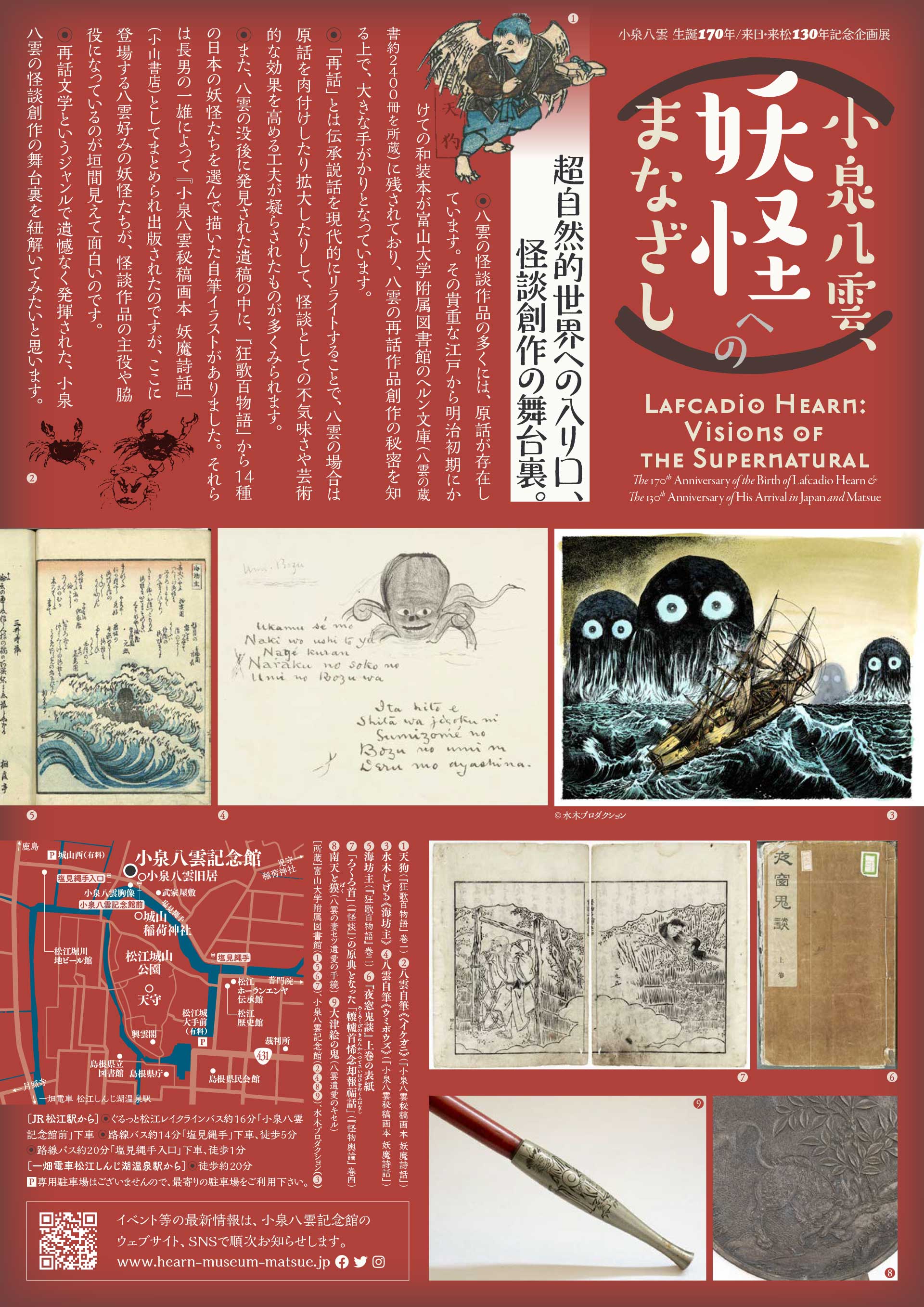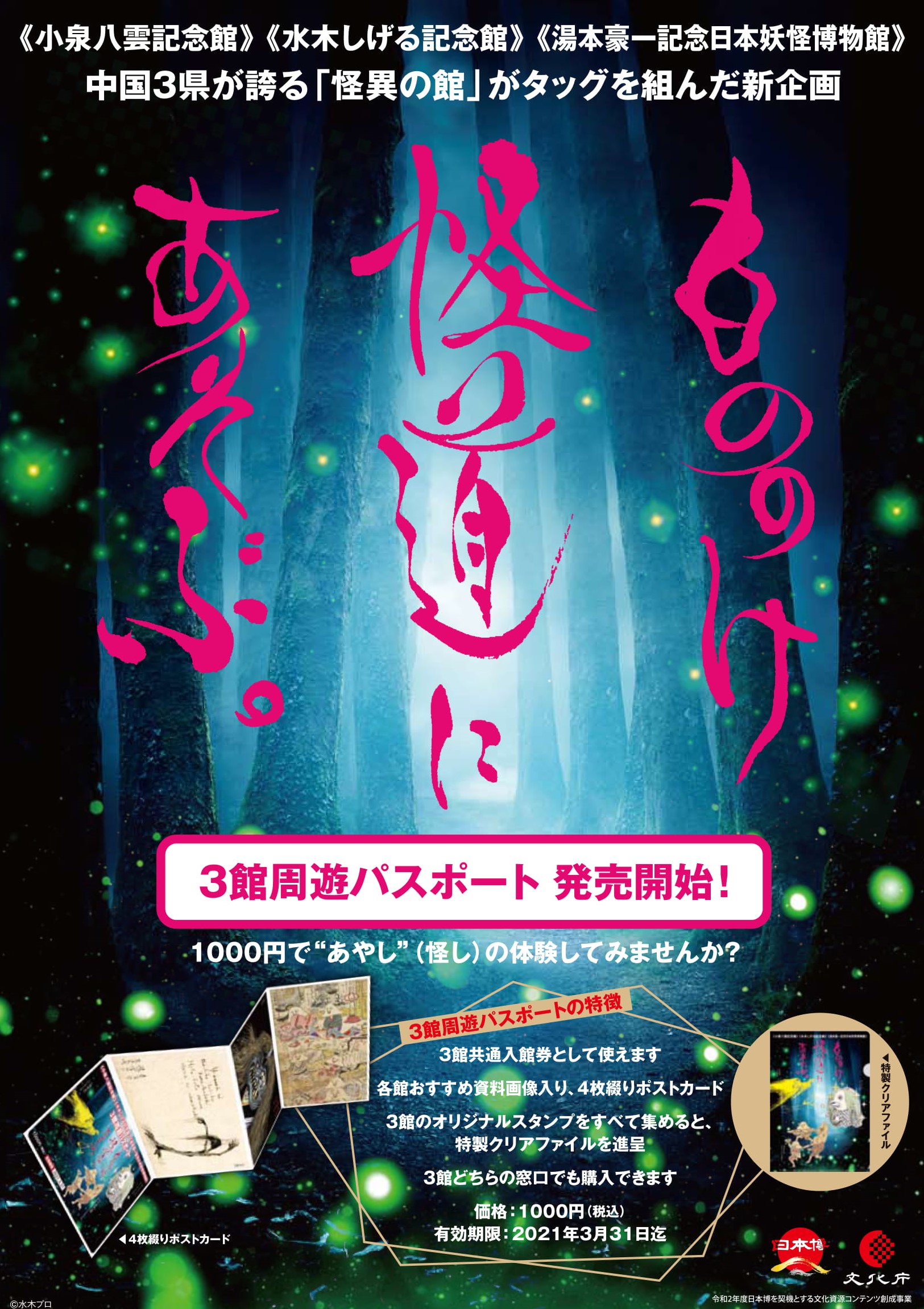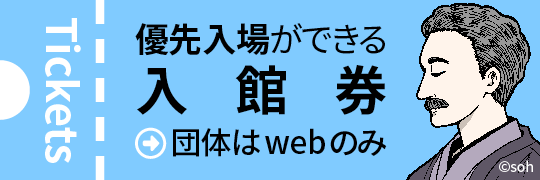企画展
小泉八雲、妖怪へのまなざし
Exhibition
Lafcadio Hearn: Visions of the Supernatural
2020年6月27日(土)―2021年6月6日(日)
1階 展示室3
小泉八雲 生誕170年/来日・来松130年記念企画展
主催:小泉八雲記念館
共催:松江市、山陰中央新報社
特別協力:富山大学附属図書館、湯本豪一記念日本妖怪博物館(三次もののけミュージアム)、水木プロダクション、水木しげる記念館
後援:八雲会、朝日新聞松江総局、毎日新聞松江支局、読売新聞松江支局、日本経済新聞松江支局、産經新聞社、時事通信社松江支局、
中国新聞社、島根日日新聞社、NHK松江放送局、TSKさんいん中央テレビ、BSS山陰放送、日本海テレビ、山陰ケーブルビジョン、エフエム山陰、エフエムいずも
ヘッダー画像:富山大学附属図書館所蔵
Saturday June 27, 2020–Sunday June 6, 2021
Exhibition Room 3
Exhibition: The 170th Anniversary of the Birth of Lafcadio Hearn & the 130th Anniversary of His Arrival in Japan and Matsue
organizer: Lafcadio Hearn Memorial Museum
co-organizers: Matsue City / The San-in Chuo Shimpo Newspaper Co., Ltd.
special cooperation: The University of Toyama Central Library / Japan Yokai Museum (Miyoshi Mononoke Museum) /
Mizuku Production / Mizuki Shigeru Museum
support: The Hearn Society / Asahi Shimbun Matsue office / Mainichi Shinbun Matsue office / Yomiuri Shimbun Matsue office / Nikkei Inc. Matsue office / Sankei Shimbun Co., Ltd. / Jiji Press Matsue office / Chugoku Shimbun / Shimane Nichi-nichi Newspaper / NHK Matsue / TSK Sanin Chuo TV / Broadcasting System of San-in Inc., / Nihonkai Telecasting Co., Ltd. / San-in Cable Vision / FM San-in / FM Izumo
header image: The University of Toyama Central Library collection
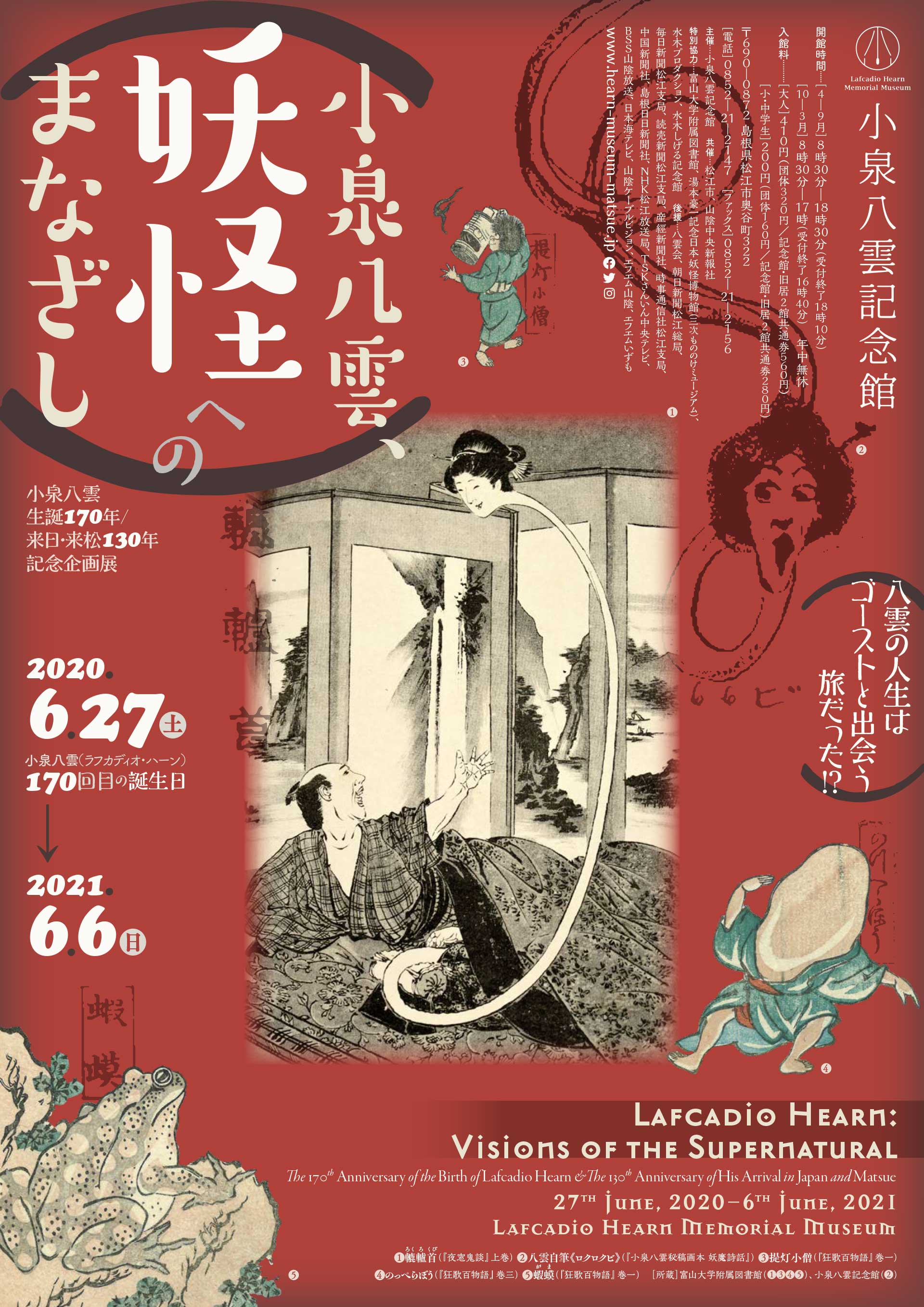
小泉八雲は、人生で70話を超える世界の怪談を採集・再話したことで知られています。いうまでもなく、妖怪文化は怪談を通して継承されるものです。八雲の妖怪文化への関心は少年時代にさかのぼりますが、アイルランド時代には乳母から妖精譚や怪談話を聞き、ときどき幽霊や幻を見る恐怖体験をしました。ニューオーリンズ、マルティニークそして日本と多神教世界の民衆が紡いだ文化に底流する妖怪や妖精の世界は、常に八雲にとって魅力的なテーマでした。人生を通して共通する八雲のまなざしは、超自然の世界に光をあてることに注がれてきたのです。
八雲が再話した作品の多くには原話が存在しています。その貴重な一次資料が富山大学附属図書館のヘルン文庫 ¹ に残されており、八雲の再話作品創作を知るための大きな手掛かりとなっています。また、八雲の没後発見された遺稿の中に、『狂歌百物語』(1853年)の中から八雲自身が選んだ14種の日本の妖怪たちを描いた自筆のイラストがありました。これらは、長男の一雄の手によって『小泉八雲秘稿画本妖魔詩話』(小山書店、1934年)としてまとめられ出版されました。
この企画展では、八雲の再話作品の中から、特に原典が確認できる江戸・明治初期の和装本(富山大学附属図書館所蔵)による約20話の比較展示、妖怪文化が花開いた江戸期の妖怪絵巻(湯本豪一記念日本妖怪博物館〔三次もののけミュージアム〕所蔵)、『妖魔詩話』より八雲の解説・イラストと『狂歌百物語』の比較展示、QRコードによる八雲作品の読み取り、さらには、妖怪漫画家水木しげるによるイラスト(水木プロダクション所蔵)などを展示します。この展示を通して、再話文学というジャンルで遺憾なく発揮された八雲の作家としての特色と、東大講義で学生に語った妖怪・怪談・再話文学への定義などを引用しながら、縦横無尽に絡み合う八雲の怪談創作の舞台裏をひも解いてみたいと思います。
八雲の予言通り、100年以上たった今でもなお、超自然的なものへの興味は色あせるどころか、ますます光を放っているように思います。超自然文学に「真理」を見出し、自然への畏怖の念とやさしさの精神の回復を望んだ八雲の妖怪へのまなざしを届けることで、妖怪を楽しむ遊び心と現代社会に必要な精神性を未来にもつないでいきたいと思います。
同時に、近隣の異界や妖怪をテーマとする「湯本豪一記念日本妖怪博物館(三次もののけミュージアム)」(広島県三次市)、「水木しげる記念館」(鳥取県境港市)との連携強化を視野に入れての交流事業を実施することで、本企画展との相乗効果を狙っていきたいと思います。
1. 富山大学附属図書館ヘルン文庫
ヘルン文庫は、1924年旧制富山高等学校(現富山大学)の開設を記念して、地元資産家の馬場はる氏が小泉八雲の蔵書約2,400冊を小泉家から購入し寄贈したことに始まる。1923年に起きた関東大震災を機に、小泉家は蔵書の安全な保管を希望。八雲の教え子、田部隆次の兄で初代校長の南日恒太郎が、譲渡を強く希望し願いが叶った。ヘルン文庫の蔵書の内容は、八雲の知識そのものであり、彼の文筆活動や講義に直接または間接的に影響を与えた資料群といえる。蔵書のジャンルは、欧米の文学作品、神話・民間伝承、歴史、哲学・宗教、東洋関係、自然科学等、多岐にわたっている。
Lafcadio Hearn is renowned for having collected and retold over 70 supernatural tales from around the world. It goes without saying that the culture of supernatural beings is passed down through ghost stories. Hearn’s interest in the culture of supernatural beings can be traced to his childhood. He heard fairy stories and ghost stories from his nanny in Ireland, and at times had frightening experiences in which he had visions of ghosts and phantoms. In New Orleans, on Martinique and in Japan, the world of supernatural beings and fairies underlies the polytheistic cultures. This was a most appealing theme for Hearn. Throughout his life, his gaze fell on the supernatural.
The originals of the stories that Hearn retold are still in existence. These precious primary resources are in The Lafcadio Hearn Library of the University of Toyama Central Library ¹. They offer great insights which are helpful in understanding Hearn’s retold stories. In the manuscripts discovered after Hearn’s death, there were illustrations by Hearn of 14 Japanese supernatural beings which he had chosen himself from Kyoka Hyaku Monogatari (1853). These were compiled by Kazuo, Hearn’s eldest son, and published as Japanese Goblin Poetry (Koyama Shoten, 1934).
In this exhibition, we will give a comparative display of around 20 of Hearn’s retold stories, for which the original texts can be confirmed. These texts are from the Edo and early Meiji periods, and are part of the collection of The Lafcadio Hearn Library. We will also present picture scrolls (from Miyoshi Mononoke Museum) from the Edo period, when the culture of supernatural beings flourished, and a comparison between Hearn’s commentary and illustrations from Japanese Goblin Poetry and Kyoka Hyaku Monogatari. Visitors will be able to read Hearn’s works through QR codes. Furthermore, we will display illustrations (from Mizuki Shigeru Museum) by the manga artist Mizuki Shigeru, who drew supernatural beings. This exhibition will show an aspect of Hearn the writer, who demonstrated his skills in the genre of retold literature. Also, by quoting definitions of supernatural beings, ghost stories and retold literature from Hearn’s University of Tokyo lectures, we will unravel the intertwined elements behind the scenes of Hearn’s creations.
As Hearn predicted, over 100 years later, interest in the supernatural has not faded, rather, it has grown. Hearn found “truth” in supernatural literature, and hoped to restore awe of nature and a gentle spirit through his vision of supernatural beings. We want to show visitors that spirituality and a playful attitude toward such beings is not inconsistent in contemporary society, and aim to connect this to the future.
At the same time, this exhibition will strengthen our connections with other cultural and tourism entities that focus on the underworld and spiritual beings—Japan Yokai Museum (Miyoshi Mononoke Museum) (Miyoshi City, Hiroshima Prefecture) and Mizuki Shigeru Museum (Sakaiminato City, Tottori Prefecture). This exhibition will generate synergy with these institutions through a planned exchange project.
1. The Lafcadio Hearn Library of the University of Toyama Central Library
The Lafcadio Hearn Library began when Haru Baba, a wealthy local citizen, bought a collection of around 2,400 of Hearn’s books from the Koizumi family, and donated them as a commemoration of the opening of the old Toyama High School (now the University of Toyama), in 1924. After the Great Kanto Earthquake in 1923, the Koizumi family had wished to store these books in a safe location. The first school principal Tsunetaro Nannichi, who was the older brother of Hearn’s student Ryuji Tanabe, was extremely keen to have the books transferred to his school, and his wish came to fruition. The collection in the Hearn library is the basis of Hearn’s knowledge. It comprises material which influenced his writing and lectures, both directly and indirectly. The collection covers a wide range of genres, including Western literature, mythology, folklore, history, philosophy, religion, the Orient, and natural sciences.
小泉八雲の再話文学
原話となった底本が存在していた
Lafcadio Hearn’s Retold Literature
Original texts that provided source material and are still in existence
ろくろ首
- 【八雲の作品】「ろくろ首」……『怪談』1904年
- 【原話】「轆轤首悕念却報福話」……『怪物輿論』巻之四、十返舎一九著画、1803(享和3)年、京都:勝村治右衛門
「ろくろ首」といえば、夜中にひょろひょろと伸びる女の首を想像するが、この話は頭が胴体から離れて飛行する不気味な首の妖怪で、豪遊無双の僧とろくろ首の対決譚。再話はほぼ原話に沿って構成されている。
八雲自身は、「化けものの歌」(『妖魔詩話』)の中で、首が伸びるろくろく首をユーモアたっぷりに描いている。
Rokurokubi
- Hearn’s work: “Rokuro-Kubi”, Kwaidan (1904)
- Original source: Kaibutsu Yoron Volume 4 (1803)
When thinking of the being “rokurokubi”, one imagines a woman with a neck which stretches in the night. However, in this story, the supernatural being is one whose head separates from its body and flies. The story is of a confrontation between a travelling priest and a “rokurokubi”. The retold tale follows the original closely. Hearn’s humourous drawing of the “rokurokubi” with its elongated neck appears in Japanese Goblin Poetry.
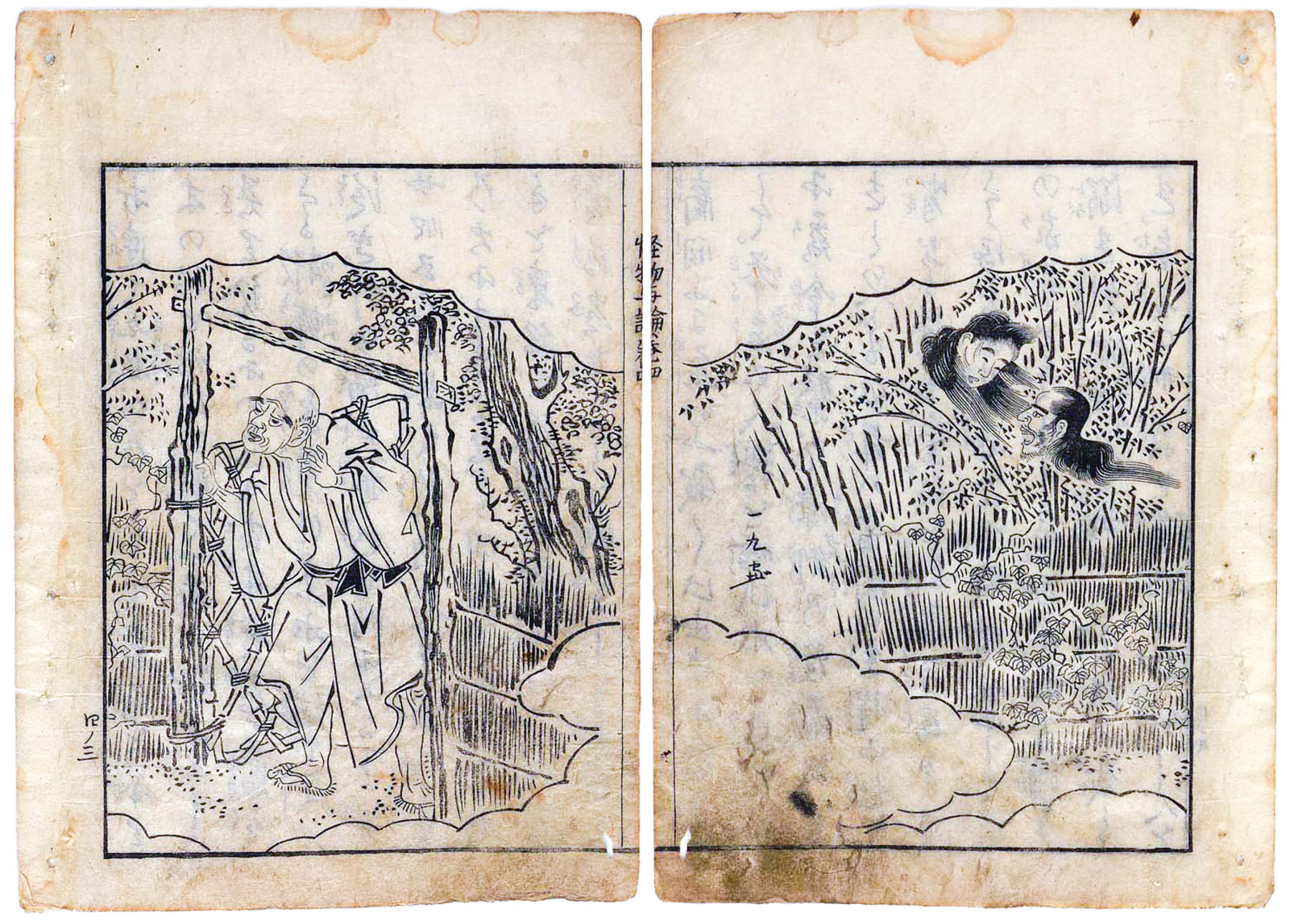
富山大学附属図書館
果心居士の話
- 【八雲の作品】「果心居士の話」……『日本雑記』1901年
- 【原話】「果心居士 黄昏草」……『夜窓鬼談』下巻、石川鴻斎編著、1893(明治26)年、東京:東陽堂
名画を操る果心居士と呼ばれる不思議な老人が、最後には屏風絵の中から現れた舟に飛び乗りその絵の中に消えてしまうという話で、「名画には必ず魂が宿り、値のつけようがない」と説く。再話では原話の筋や展開など細部にわたって活かしている。八雲は、物語はもちろんだが、見事な挿絵にもインスピレーションを得たに違いない。
Kwashin Koji
- Hearn’s work: “The Story of Kwashin Koji” A Japanese Miscellany (1901)
- Original source: Yasokidan Volume 2 (1893)
The story is about a strange elderly man called Kwashin Koji, who exhibited masterpiece paintings. At the end of the story, he jumps into a boat which appears in a painting on a folding screen and disappears into the picture. The story explains that there are always souls in masterpieces, and a value cannot be placed on them. In the retold work, Hearn uses the story and its development in detail. Hearn must surely have been inspired not only by the tale, but also by the wonderful illustrations.
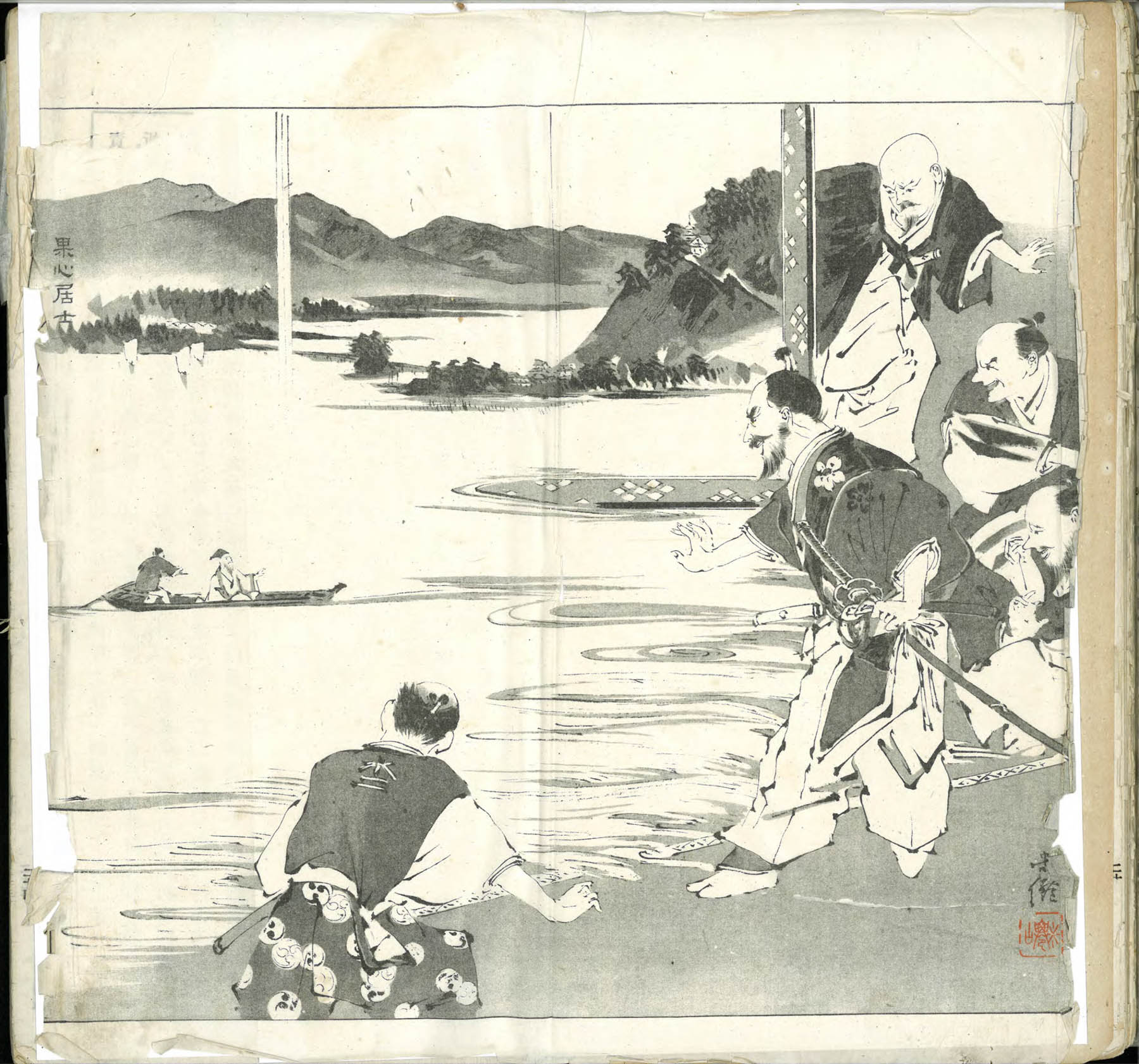
富山大学附属図書館
おしどり
- 【八雲の作品】「おしどり」……『怪談』1904年
- 【原話】「魚虫禽獣」第三十……『古今著聞集』巻二十、橘成季著、1770(明和7)年、大阪:柏原屋清右衛門
この作品は、平安時代から鎌倉時代までの説話700編余を30分類に分けて収めた『古今著聞集』を底本とした。雄のおしどりが殺された悲しみのあまり、雌は夫を殺した猟師の前で胸を突裂いて自害するという話で、原話はごく短編だが再話では3倍の長さで美しく描き出し、より印象的でドラマチックな結末に仕上げた。
Oshidori
- Hearn’s work: “Oshidori” Kwaidan (1904)
- Original source: Kokon Chomonju Volume 20 (1770)
This work is based on a story from Kokon Chomonju which contains 700 stories divided into 30 categories. They are all from the Heian (794-1185) to the Kamakura (1185-1333) periods. In the story, a hunter kills a male oshidori (mandarin duck), and the female, so distraught at losing her husband, tears open her body and kills herself in front of the hunter. The retold story is three times the length of the original story, and is related in clear language with an impressive and dramatic ending.
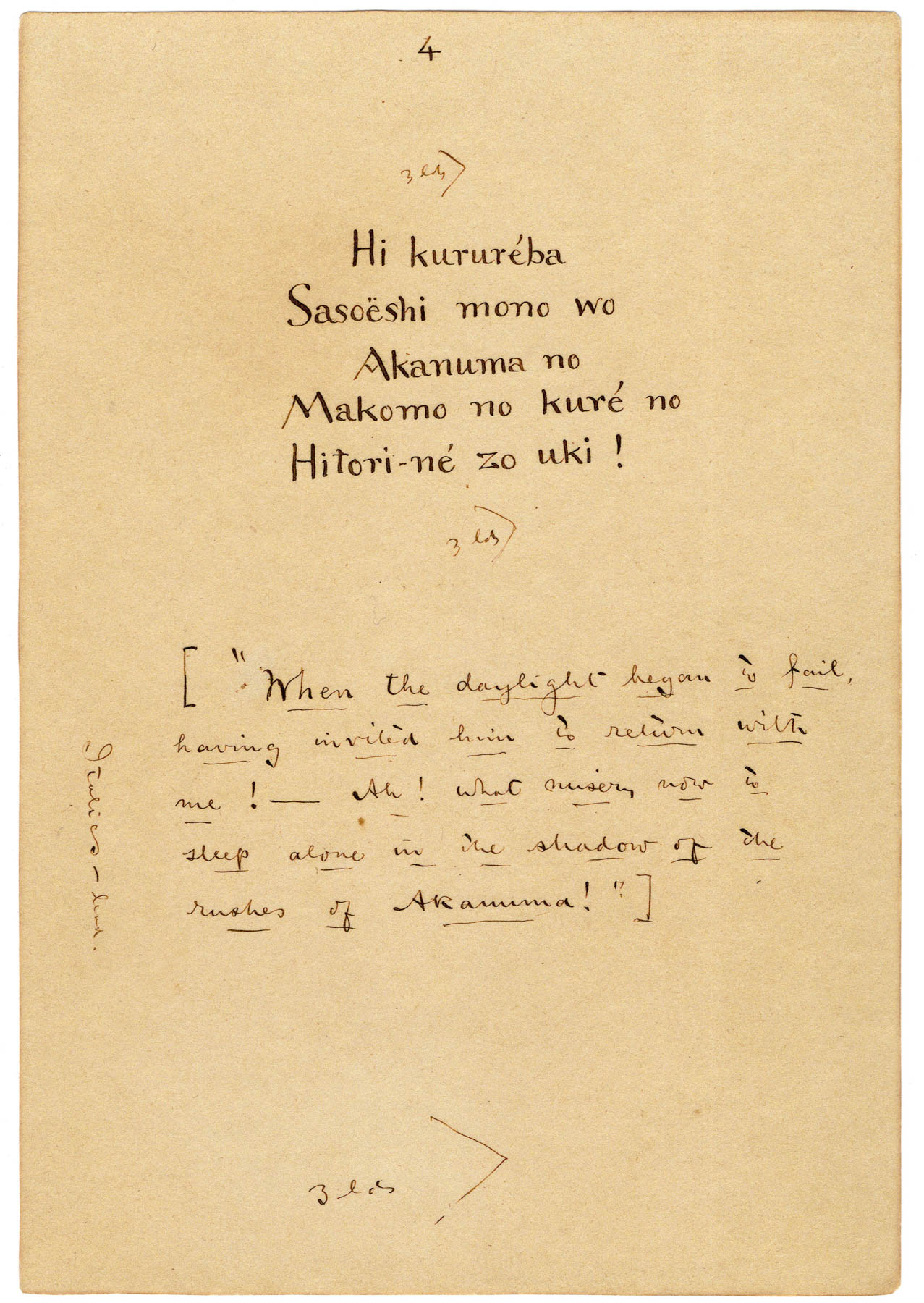
小泉八雲記念館
八雲が愛した妖怪たち
Yokai that Hearn Loved
ウミボウズ
- 【八雲の作品】「ウミボウズ」……「化けものの歌」『天の川縁起』1905年/『小泉八雲秘稿画本 妖魔詩話』1934年
- 【原典】「海坊主」……『狂歌百物語』中編、天明老人編纂、竜斎閑人正澄画、1853(嘉永6)年、出版社不明
『狂歌百物語』は、妖怪をテーマとした狂歌に妖怪画の挿絵を添えて構成された狂歌絵本。八雲はこの中から14の妖怪を選び、狂歌に解説を添えた(「化けものの歌」『天の川縁起』)。これらは八雲自筆のイラストとともに、長男の一雄によって『妖魔詩話』として刊行され、八雲の妖怪研究を知る上で貴重な資料となっている。
これらの妖怪の内の多くを、後に漫画家の水木しげるも取り上げ、作画しているのも興味深い。
Umibozu
- Hearn’s work: “Umibozu” Japanese Goblin Poetry (1934)
- Original source: Kyoka Hyaku Monogatari Volume 2 (1853)
Kyoka Hyaku Monogatari is an illustrated book of poems on the theme of Yokai. Hearn chose 14 of the supernatural beings, and added commentary to the poems to create the work “Goblin Poetry” in The Romance of the Milky Way. His eldest son, Kazuo, published these, along with Hearn’s illustrations, in Japanese Goblin Poetry. This publication is a significant resource in understanding Hearn’s research into supernatural beings. It is also interesting to note that many of these Yokai were later selected and drawn by the manga artist Shigeru Mizuki.
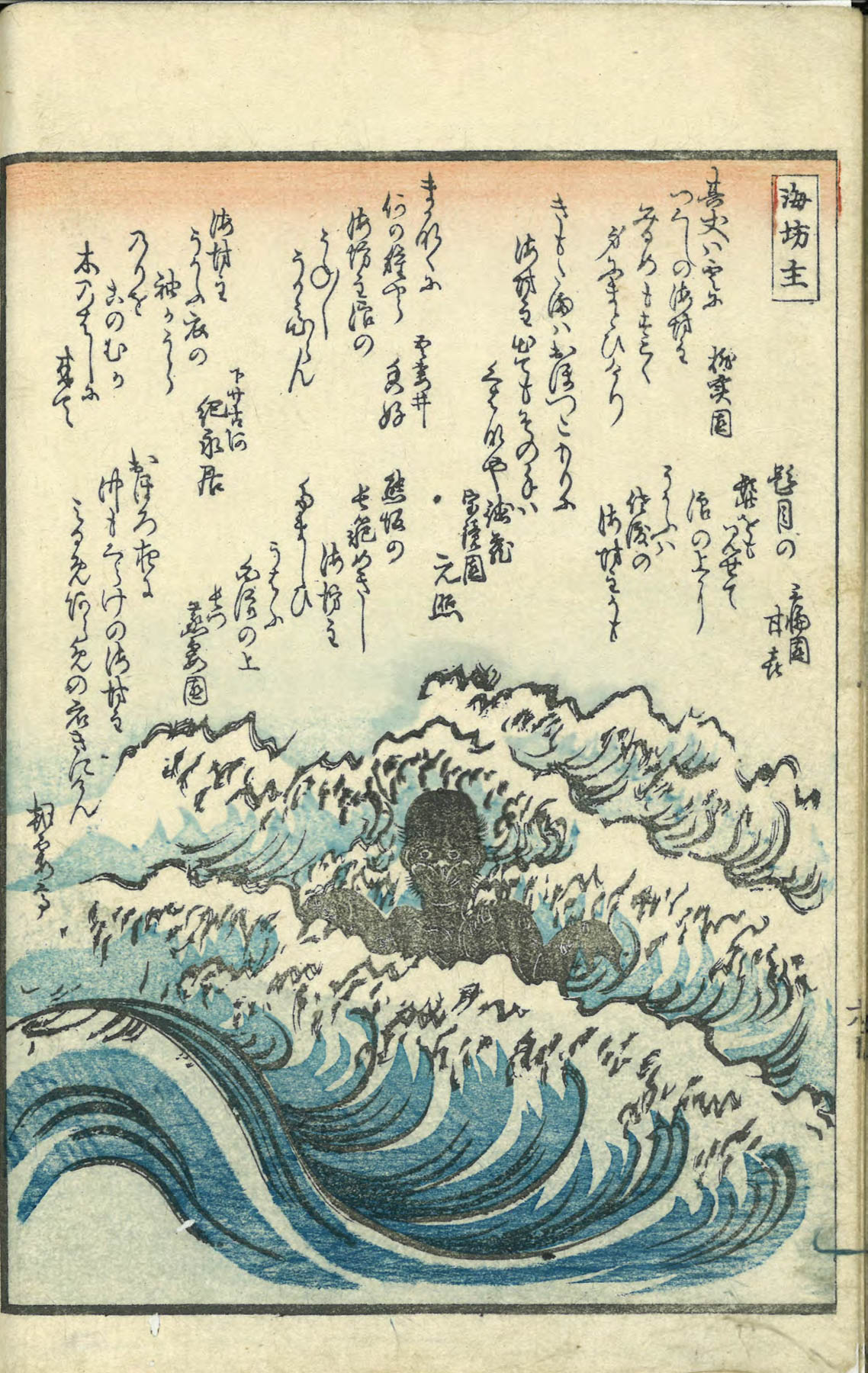
富山大学附属図書館
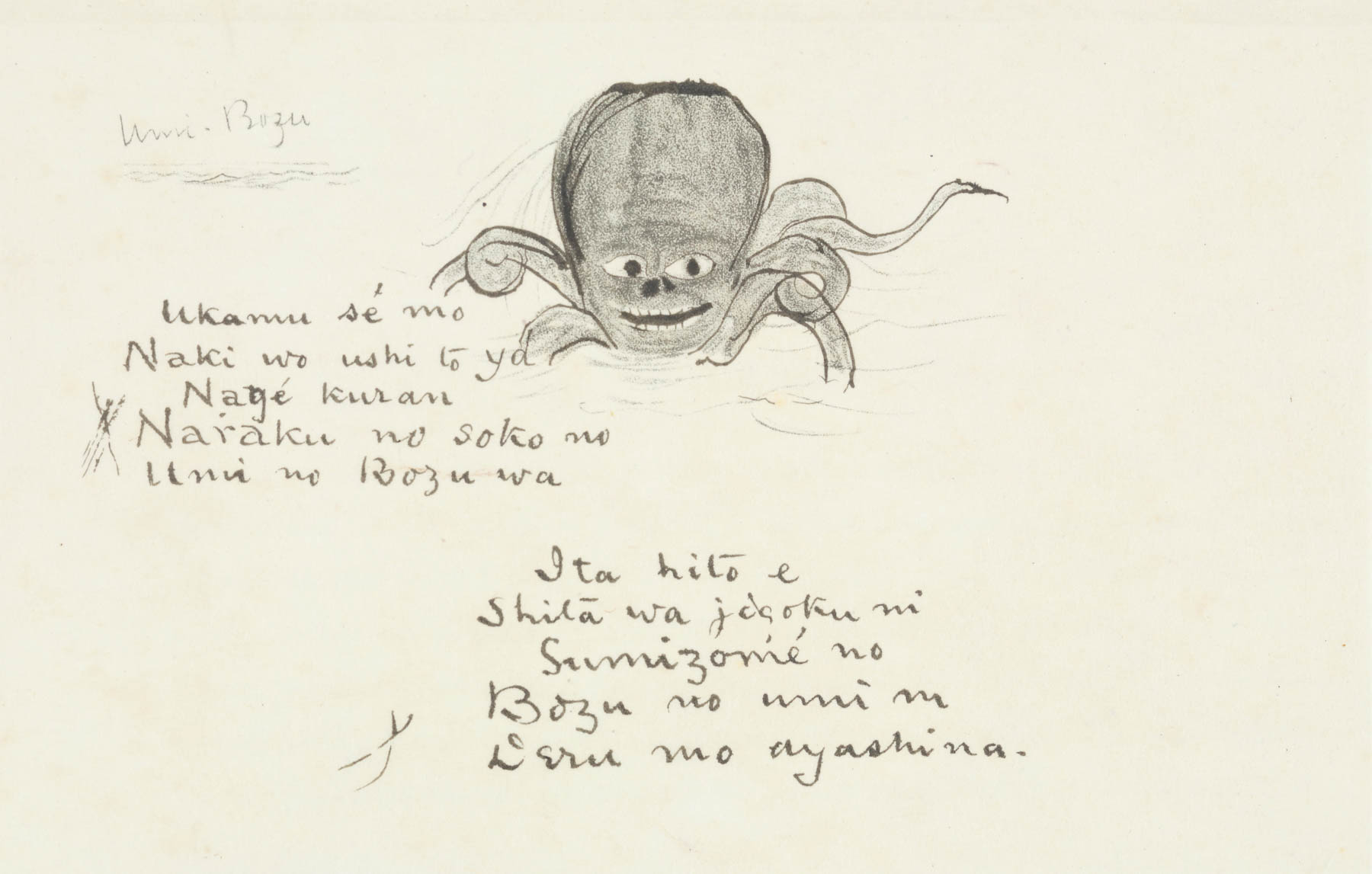
小泉八雲記念館
セツが支えた怪談創作
八雲の怪談再話には、妻のセツの支えが不可欠だった。日本語が読めない八雲にとって、古書店をめぐって古本を買い集めては、話を聞かせたセツの存在は、あまりにも大きい。八雲は書棚に並べられた自分の著書を見せては、いつもセツに感謝していた。
また、セツは怪談好きな夫のために、「お化け行燈」と呼ばれる紙製玩具や、「獏の手鏡」など、いかにも八雲が喜びそうなものを買い集めて八雲に提供した。
Setsu’s Role in Hearn’s Creation of Ghost Stories
The support of Hearn’s wife, Setsu, was essential to his retelling of ghost stories. Hearn could not read Japanese. Setsu played a large role in the creation of his stories. She bought old books in second-hand book shops and related the stories to Hearn. When Hearn looked at his publications on his shelves, he was always grateful to Setsu. She also bought things which would make her ghost story-loving husband happy, such as paper toys called “haunted lanterns” and a hand mirror illustrated with a supernatural being called “baku”.
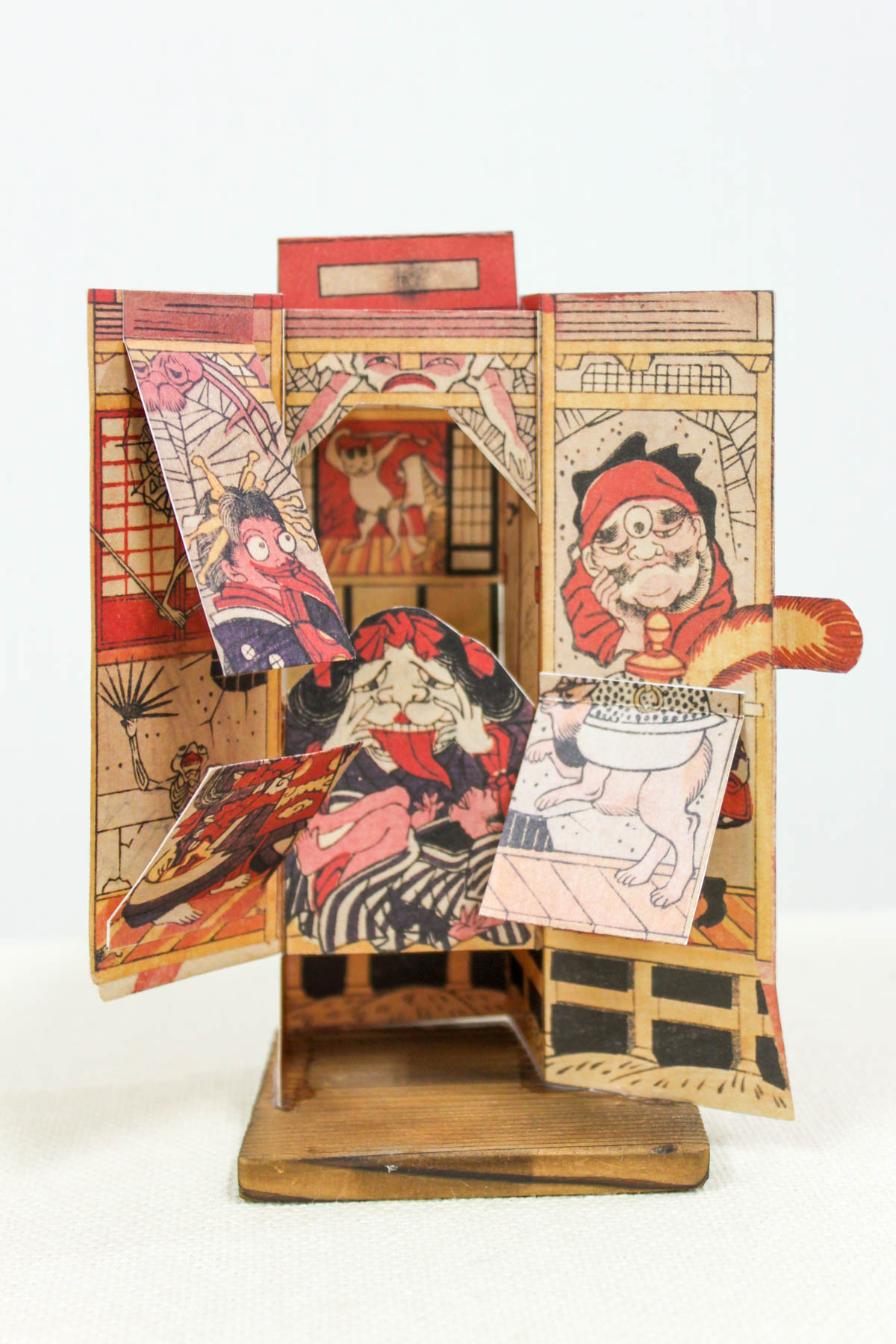
小泉八雲記念館
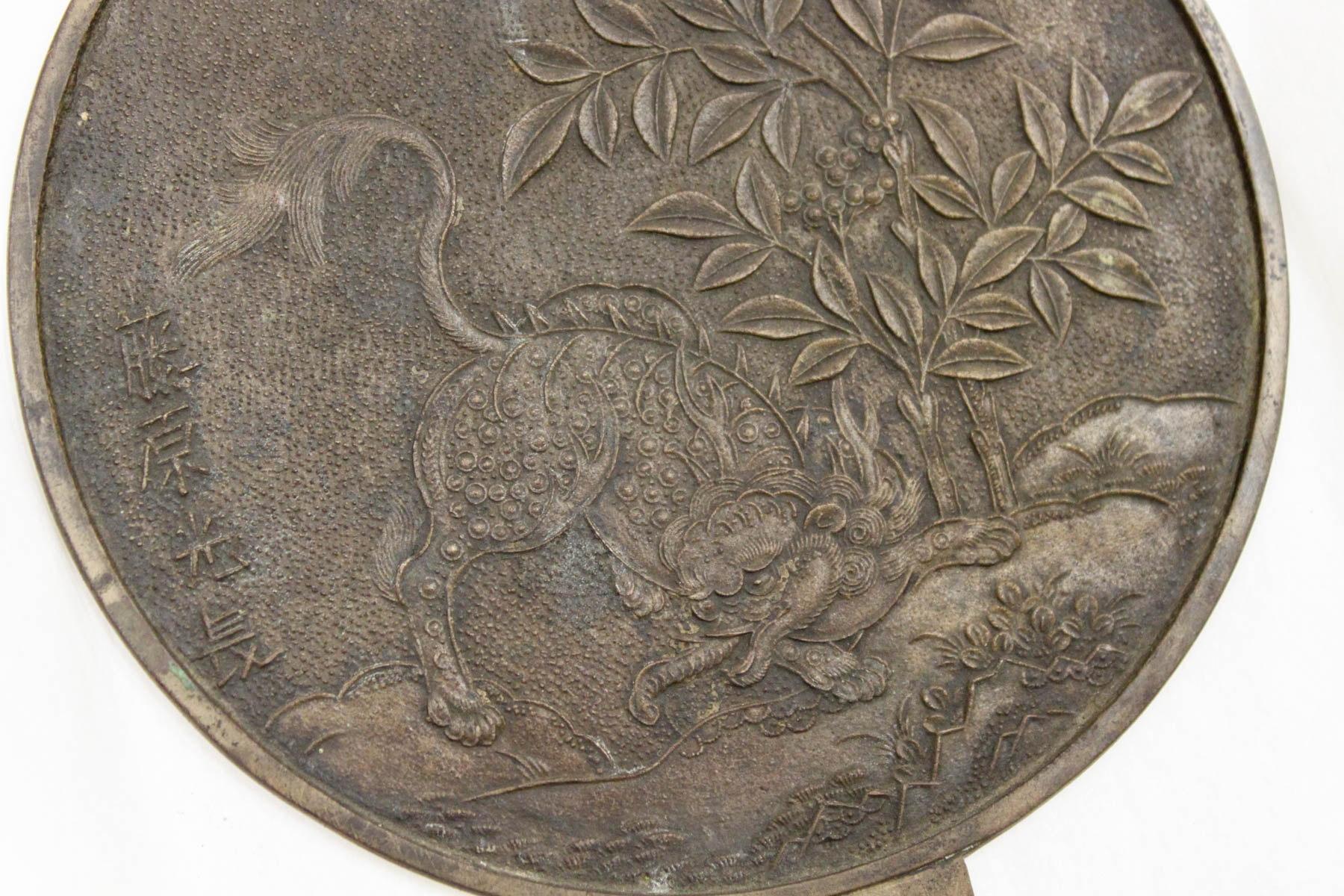
小泉八雲記念館
参考文献
- 小松和彦『妖怪文化入門』(角川ソフィア文庫)
- 平川祐弘編『怪談・奇談』(講談社学術文庫)
- ラフカディオ・ハーン著、池田雅之訳『新編日本の怪談』I・II(角川ソフィア文庫)
- ラフカディオ・ハーン著、池田雅之訳『小泉八雲東大講義録』(角川ソフィア文庫)
- 荒俣宏『アラマタヒロシの妖怪にされちゃった事典』(秀和システム)
- 笹間良彦『日本未確認生物事典』(角川ソフィア文庫)
- 柳田国男『妖怪談義』(講談社学術文庫)
- 小泉節子『思い出の記』(恒文社)
- 小泉一雄編『妖魔詩話』(小山書店)
- 小泉八雲著、平井呈一訳『日本瞥見記』上・下、『東の国から・心』、『日本雑記他』、『怪談・骨董他』(恒文社)
- 『狂歌百物語』上・中・下(嘉永6年、富山大学附属図書館所蔵)
- 森亮『小泉八雲の文学』(恒文社)
- 小泉凡「小泉八雲にみる説話伝承と再話怪談」『昔話――研究と資料』46(日本昔話学会) 他
- 寺田寅彦『小泉八雲秘稿画本妖魔詩話』
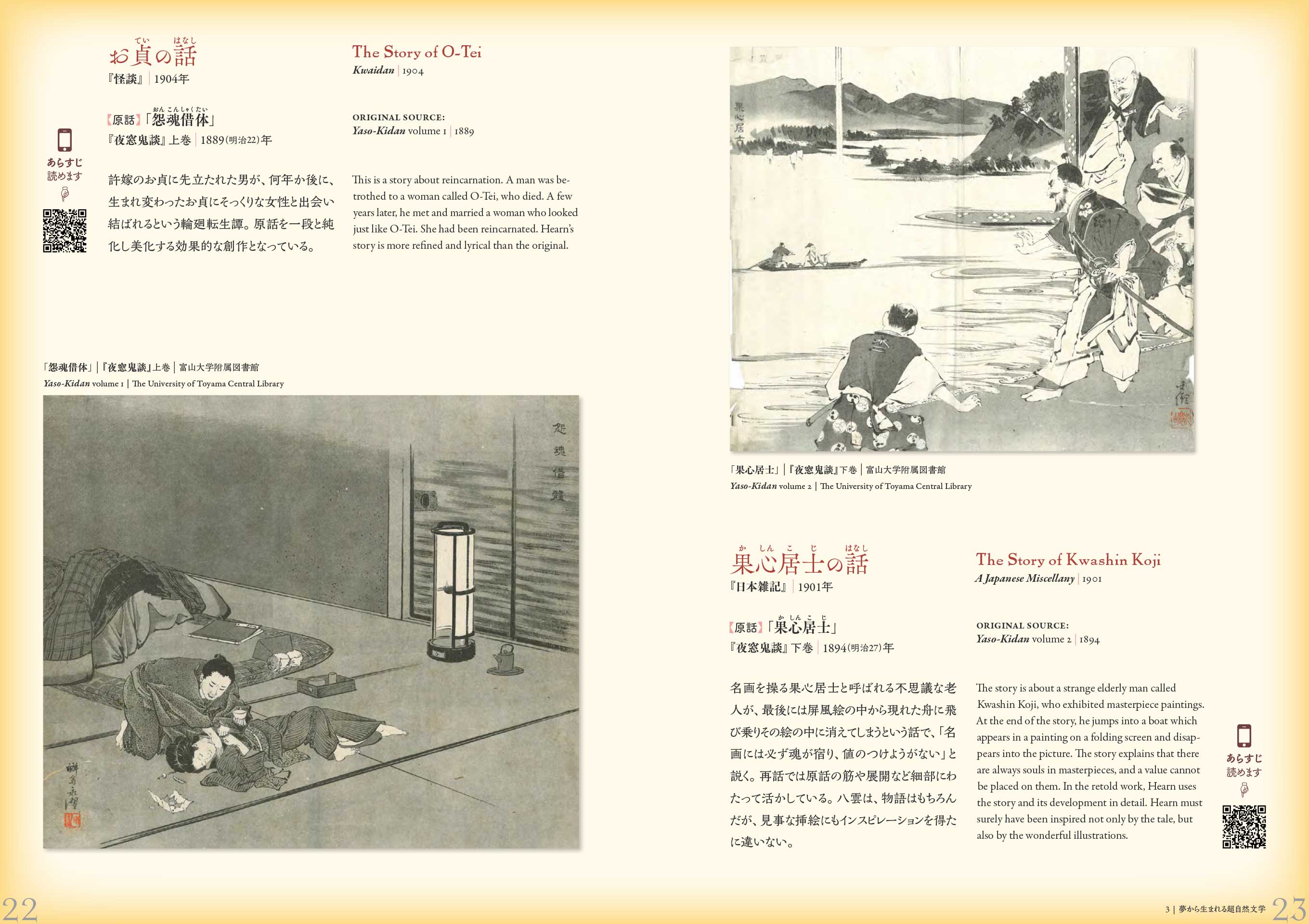
The Exhibition Catalog
本体1,3000円+税
¥1,300 (excluding tax)
1階ミュージアムショップおよび郵送販売にて取り扱います。
